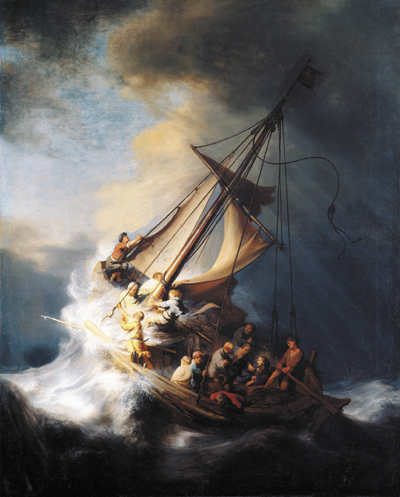In case you haven’t heard, the FBI is looking for some paintings.
It was big news this week when the FBI announced that it knows who stole paintings and other art from Boston’s Isabella Stewart Gardner Museum in 1990, the world’s greatest-ever property theft, price-wise.
Monday’s announcement, on the 23rd anniversary of the crime, came with a billboard publicity campaign in Philadelphia and Connecticut asking for return of the art. The reward is $5 million.
We won’t be seeing any of those billboards in central Maine, but that doesn’t mean the FBI hasn’t looked for the stolen art here.
To catch you up: In the wee hours of the morning March 18, 1990, two men dressed as police officers knocked on a side door of the museum and were let in, against regulations, by a security guard. The men tied up the museum’s two guards, deposited them in the basement, and over the next 81 minutes stole 13 works of art, including several Rembrandts, a vase and the finial from the staff of a Napoleonic flag.
The fake cops were never caught, the art never found. The FBI has spent the past 23 years tracking down thousands of tips, culminating in Monday’s announcement.
What does any of this have to do with Maine?
In 1992, according to the FBI, a Connecticut mobster named Robert Gentile went hunting in Madison, Maine, with an associate who lived there, Robert Guarante.
Guarante, described in news reports as a mobster, died in 2004. But his wife told both the FBI and The Boston Globe in 2012 that she saw her husband pass a tube holding a painting to Gentile sometime around 2003.
In Wednesday’s Boston Globe, Guarante is described as someone “who has been tied to almost anyone mentioned as a person of interest in the heist.” Particularly Gentile, who the Globe says is the man who the FBI has trained its focus on in recent years as it weeds through tips on the robbery.
Guarante once showed the painting he later gave to Gentile to his wife, rolling it out of the tube he kept it in. She told the Globe it didn’t look like any of the ones stolen from the Gardner.
News accounts say it wasn’t a Gardner painting, but one stolen in a different robbery.
That didn’t keep the FBI from visiting Maine in 2009 and searching Guarante’s Madison property for the stolen Gardner art. They didn’t find anything.
Hard to believe any of that art would be under some barn floorboards in Madison, but that’s the nature of art theft.
Sure, most would think by now someone would have made millions — maybe billions — on the stolen art. The most significant piece, Rembrandt’s “The Storm on the Sea of Galilee,” is estimated to be worth between $300 million and $500 million.
The problem with art theft, though, is that no matter how much the paintings are worth, they are very, very hard to get rid of.
“There is no real market for stolen masterpieces,” Anthony Amore and Tom Mashpee write in “Stealing Rembrandts.”
“They are quite simply too famous to sell.”
So the art sits. Some thieves think they can get a ransom from a museum (this never emerged as a motive in the Gardner robbery), but museums don’t do that, the robbers find.
“The characters who steal famous works often have no backup plan other than to sit on their trove and see what develops,” the pair write.
Amore is head of security at the Gardner Museum. Mashpee is a journalist.
In their book they debunk the “Dr. No fallacy.” The belief — spurred by the 1962 James Bond movie, “Dr. No” — that an eccentric millionaire commissions art thieves to steal priceless paintings so he can hang them in a secret room in his mansion, where he can gaze at them, laughing evilly while sipping scotch, presumably.
“The reality is far more grimy and far less romantic,” they write. Most art theft is committed by “common criminals associated with local crime rings.”
Boy, that takes all the fun out of the story.
The art stolen from the Gardner wasn’t handled with care; it was ripped from its frames. Treated like loot, not art.
Mashpee was once led blindfolded into a Massachusetts warehouse where shadowy men took a rolled canvas out of a poster tube and let him have a brief look by flashlight. “The Storm on the Sea of Galilee”? Maybe. Maybe not. It’s hard to tell in a dark warehouse with a brief glimpse by flashlight.
That’s the kind of story the Gardner heist is.
Boiled down to the particulars, it is, yes, grimy and far less romantic.
And the Maine connection?
No windswept stone mansion out on the coast with waves crashing below and a secret gallery lovingly displaying “The Storm on the Sea of Galilee” for an eccentric billionaire owner.
Much more grimy.
Some of the most beautiful paintings ever created, made to be appreciated and loved, remain rolled up in tubes, if not under floorboards in a Maine barn, then in some Philadelphia warehouse or Connecticut back closet.
Not romantic at all. Just pointless.
Maureen Milliken is news editor of the Kennebec Journal and Morning Sentinel. Email her at mmilliken@mainetoday.com. Kennebec Tales appears the first and third Thursday of the month.
Send questions/comments to the editors.




Success. Please wait for the page to reload. If the page does not reload within 5 seconds, please refresh the page.
Enter your email and password to access comments.
Hi, to comment on stories you must . This profile is in addition to your subscription and website login.
Already have a commenting profile? .
Invalid username/password.
Please check your email to confirm and complete your registration.
Only subscribers are eligible to post comments. Please subscribe or login first for digital access. Here’s why.
Use the form below to reset your password. When you've submitted your account email, we will send an email with a reset code.